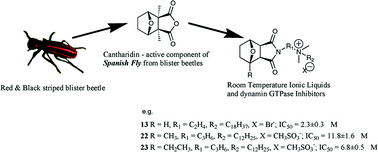From Spanish fly to room-temperature ionic liquids (RTILs): synthesis, thermal stability and inhibition of dynamin 1 GTPase by a novel class of RTILs†
Abstract
In a series of simple synthetic manipulations the active component of the aphrodisiac Spanish fly has resulted in the generation of a new family of room-temperature ionic liquids (RTILs). These RTILs are synthesized in high yield from readily attainable starting materials and can be generated in either meso or chiral forms dependant on the starting furan analogue. Substituted furans (2-methyl and 2-ethyl) afford chiral RTILs, furan affords a family of meso RTILs. In all cases the counterion was crucial, with CH3SO3– consistently displaying the lowest melting points. Of the RTILs synthesized, TGA plots showed most to be stable up to at least 250 °C. We had sought to use these RTILs in a series of dynamic combinatorial chemistry (DCC) assembly reactions via solubulisation of dynamin


 Please wait while we load your content...
Please wait while we load your content...